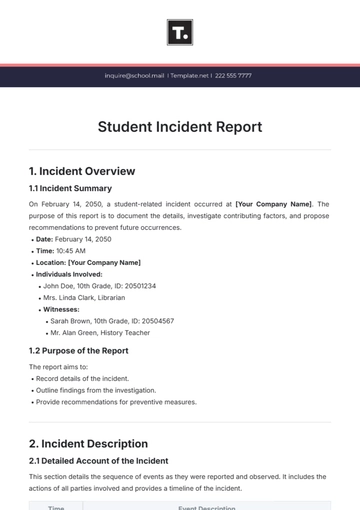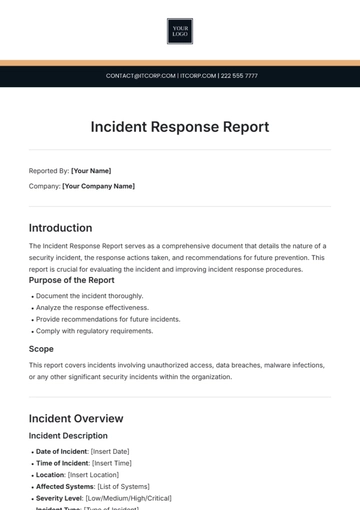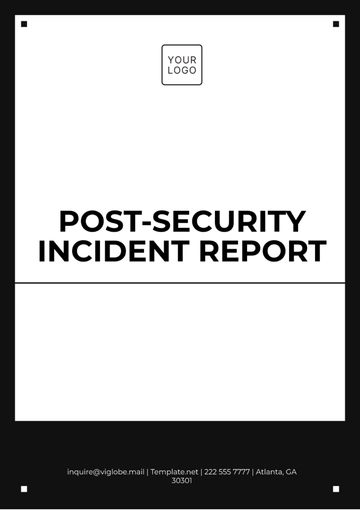Security Breach Incident Report
I. Incident Details
Date and Time: [DATE AND TIME]
Location: [YOUR COMPANY ADDRESS]
Severity Level: (e.g., low, moderate, high)
II. Description of the Incident
The incident, a sophisticated phishing attack, involved unauthorized access to sensitive customer data due to employees being tricked by fake emails from supposed colleagues. This led them to install malware by clicking malicious links, which attackers used to exploit a hidden vulnerability in the company's email server, bypassing security to access names, addresses, and payment details stored in the database.
III. Impact Assessment
The breach compromised the confidentiality, integrity, and availability of sensitive customer data and essential business services.
Confidentiality:
PII like names, addresses, and payment card details were exposed.
Access to confidential business data, including proprietary information, was possible.
Integrity:
Availability:
Consequences:
Financial losses from fraudulent transactions and regulatory fines.
Reputational damage, decreased customer loyalty, and negative publicity.
Risk of penalties and sanctions due to regulatory compliance violations.
IV. Response Actions
A. Immediate Response
Isolation of Affected Systems: All affected systems were immediately isolated upon discovery to prevent further breaches and data loss.
Disabling Compromised Accounts: Suspected compromised user accounts were quickly disabled to prevent unauthorized access and minimize damage.
Implementing Access Controls: Access controls were tightened to restrict access to sensitive data and critical systems, limiting the scope of the breach.
B. Further Investigation
Forensic Analysis: Forensic experts analyzed affected systems, reviewing logs, network traffic, and file integrity to assess the breach's scope and trace the attacker's activities.
Interviewing Personnel: Key personnel involved in the incident or with relevant knowledge were interviewed to gather additional information and insights into the breach.
Malware Analysis: All malware found during the investigation underwent thorough analysis to determine its functionality, origins, and potential effects on the organization's infrastructure.
Root Cause Analysis: A root cause analysis was performed to pinpoint vulnerabilities that led to the breach by evaluating security measures and identifying areas for enhancement.
V. Investigation Findings
A. Root Cause
B. Exploited Vulnerabilities
Unpatched Software: The attackers exploited known vulnerabilities in the outdated software of the email server to gain unauthorized access.
Phishing Attack Vector: The attackers used a complex phishing scheme to trick employees into disclosing their credentials, and gaining initial access to the organization's network.
C. Weaknesses in Security Controls
Patch Management: The organization lacked a robust patch management process to ensure the timely application of security updates and patches across its infrastructure.
User Awareness Training: Insufficient employee training and awareness regarding phishing threats contributed to the success of the attackers' social engineering tactics.
Access Controls: Inadequate access controls allowed the attackers to move laterally within the network and escalate privileges, facilitating unauthorized access to sensitive data.
VI. Recommendations
To mitigate the risk of similar incidents in the future, the following recommendations are proposed:
Patch Management: Ensure timely patching of software and systems to address known vulnerabilities.
Employee Training: Conduct regular security awareness training to educate employees about common threats and best practices.
Access Controls: Implement robust access controls and least privilege principles to restrict unauthorized access.
Incident Response Plan: Review and update the incident response plan to enhance readiness for future security incidents.
VII. Follow-up Actions
To ensure the effectiveness of implemented measures and prevent recurrence, the following follow-up actions will be undertaken:
Ongoing Monitoring: Implement continuous monitoring of systems and networks for suspicious activities.
Regular Audits: Conduct periodic security audits to assess the effectiveness of security controls and procedures.
Incident Response Testing: Conduct regular tabletop exercises or simulated incident response drills to evaluate the organization's readiness to handle security incidents.
For any further inquiries or clarifications, please contact [Your Name] at [Your Email] or [Your Company Name] at [Your Company Email].
Incident Report Templates @ Template.net






























